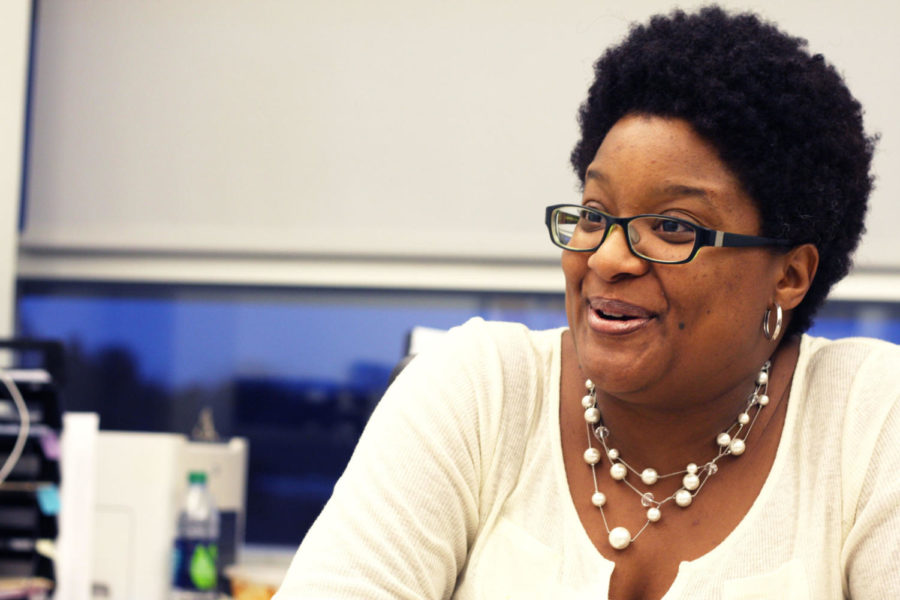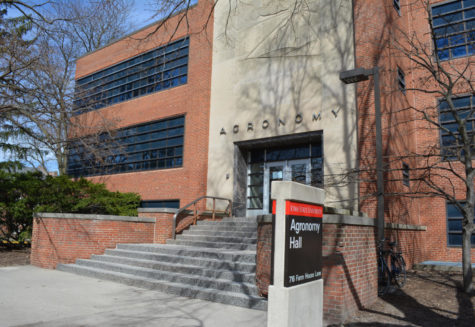End of an era for ISU ADVANCE Program
Photo By:Kendra Plathe/Iowa State Daily
Malika Jeffries-El, a participant of the ISU ADVANCE program, shares her story on Monday, Nov. 7, of how the program benefited her. The ISU ADVANCE program works on increasing the number of women in science, technology, engineering and mathematic fields.
November 7, 2011
For the past five years, the ISU ADVANCE Program has been working to increase the number of women in science, technology, engineering and mathematics fields.
A $3 million grant was given to Iowa State in 2006 by the National Science Foundation ADVANCE Program, and in 2011 has reached its five-year end. While some funds still remain, it is now time to evaluate the results and work on “institutionalizing” the changes that have resulted.
“Some things will end, but many things that we have found to be important, parts of the campus are finding ways to keep it going and so that is what institutionalization is about, keeping it going because the campus values it,” said Bonnie Bowen, executive director of the ISU ADVANCE program.
In 2006, the program identified four goals specifically for Iowa State. These goals were: To overcome known barriers to the advancement of women faculty in STEM disciplines, to identify and eliminate department-specific barriers, to increase the representation of women and underrepresented minorities at senor faculty and leadership ranks, and to institutionalize positive change across the university.
At Iowa State the clearest achievement can be seen in the number of women in higher-level leadership. From 2006 until 2010 the percentage of women in STEM fields increased from 25 percent to 50 percent, with that percentage maybe even being slightly higher today, said Bowen. There was also a 35 percent increase in the number of full professors in the STEM fields.
“Women are underrepresented in the sciences, and there doesn’t seem to be a real reason, based on ability, they should be,” said Charles Glatz, chemical engineering professor at Iowa State and current ADVANCE professor.
Bowen added, “The number of full professor women has increased, and that is a sign that people are staying in their careers and being productive and being recognized as productive. They are getting full credit for their productivity.”
Overall, the number of women faculty at Iowa State has increased only marginally if that, but another program achievement is the change in conversation among faculty members.
“When we summarize what has happened with ADVANCE over these last five years, people say the conversation has changed. In other words, people are willing to talk about things that before they might not have even thought about talking about,” said Diane Debinski, professor of ecology, evolution and organismal biology. “People are thinking and talking about the important issues, the issues we have identified and the issues that nationally have been identified. People are talking about those more on the ISU campus among the faculty.”
Debinski has also been involved with ISU ADVANCE from the very beginning in 2002 and until the program’s end in 2011. Debinski believes the reason ISU ADVANCE was a success was because the program had a core group of leaders that saw the project through until the end.
“We had a really dedicated core group of people across multiple colleges and from different disciplines that were extremely dedicated,” Debinski said.
Glatz, who now serves as an ADVANCE professor but in the past was an Equity Adviser for the College of Engineering, explained that one of the best practices Iowa State can continue is the college-level Equity Advisors. As an Equity Advisor he worked closely with department chairmen and search committees to find the best ways to improve the departmental climate at Iowa State.
“We had specific in-college roles, and those were to disseminate what had been learned to enable other people to have better practices,” Glatz said, but ultimately, his goal was to make “this a better place for women faculty to succeed.”
When asked what men can do to create a better work climate for women, Glatz said men can “avoid some behaviors that tend to be associated with men more, which is not listening to somebody that is around the table, or not giving people a chance to contribute. … We could be a much better place to work if we do these things.”
Bowen, also an evolutionary biology professor at Iowa State, most importantly has seen a change among young women faculty members.
“Young faculty have a reaction that improved between 2005 and 2009, and we are one of the leaders among our peers in these kinds of issues. … We are perceived positively by the junior faculty, the younger people. That is important for people want to come here,” Bowen said.
Malika Jeffries-El was a participant in the ISU ADVANCE Program and was strongly influenced by the program. She said the part that benefited her the most was the opportunity to have a mentor.
“They can look at it from the outside looking in and offer different perspective and feedback on various things throughout my career. [My mentor] was very helpful. … He helped me with publishing, giving me feedback on publications and grants,” Jeffries-El said. She was asked to find a mentor who would be preeminent in her field and not from Iowa State. Her mentor was the chairman of the chemistry department at MIT, Timothy Swager.
As a result of the program Malika Jeffries-El, now associate chemistry professor, sees real results when discussing young women faculty.
“I think a lot of women found their voice. A lot of us became more informed about what we were entitled to or deserved,” Jeffries-El said. “I think it was always an accepted fact that there just aren’t that many women faculty in STEM. I think everyone just accepted it. … But no one really tried to understand why. I think there has been a lot more conversations about why this is and what can be done about it, whereas before it was just more of a statement of fact.”
“Our project was not all about numbers, the goals also had to do more with department culture and communicating about how you do faculty searches. Ultimately you want the numbers to change, but our project was about having those changes happen through changes in culture,” Bowen said.

















